Expression and cellular localization of inducible nitric oxide synthase in lipopolysaccharide-treated rat kidneys
- PMID: 22260992
- PMCID: PMC3351238
- DOI: 10.1369/0022155411436131
Expression and cellular localization of inducible nitric oxide synthase in lipopolysaccharide-treated rat kidneys
Abstract
Although inducible nitric oxide synthase (iNOS) is known to play significant roles in the kidney, its renal localization has long been controversial. To resolve this issue, the authors identified iNOS-positive cell types in rat kidneys using double immunohistochemistry and confirmed iNOS positivity using enzyme histochemistry with NADPH-diaphorase (NADPH-d) and in situ RT-PCR. Adult male Sprague-Dawley rats were injected intraperitoneally with lipopolysaccharide (LPS) or saline as a control and sacrificed at various time intervals after injection. Quantitative real-time reverse transcriptase polymerase chain reaction showed that iNOS was not expressed in control kidneys but was induced in LPS-treated kidneys. iNOS immunostaining was strongest 6 to 18 hr after injection and decreased gradually to control levels by day 7. Double immunohistochemistry and NADPH-d revealed that iNOS expression was induced in the interstitial cells, glomerular parietal epithelial cells, the proximal part of the short-looped descending thin limb, the upper and middle papillary parts of the long-looped descending thin limb, some inner medullary collecting duct cells, and almost all calyceal and papillary epithelial cells. The present study determines the precise localization of iNOS in LPS-treated rat kidneys and provides an important morphological basis for examining the roles of iNOS in sepsis-induced acute kidney injury.
Conflict of interest statement
The authors declared no potential conflicts of interest with respect to the authorship and/or publication of this article.
Figures

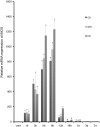


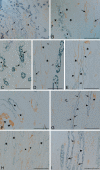

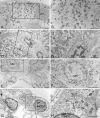

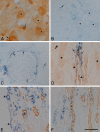
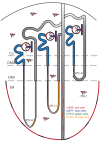
Similar articles
-
Time course of lipopolysaccharide-induced nitric oxide synthase mRNA expression in rat glomeruli.J Lab Clin Med. 1999 Nov;134(5):471-7. doi: 10.1016/s0022-2143(99)90168-3. J Lab Clin Med. 1999. PMID: 10560940
-
In situ hybridization localization of mRNA encoding inducible nitric oxide synthase in rat kidney.Am J Physiol. 1994 Nov;267(5 Pt 2):F748-57. doi: 10.1152/ajprenal.1994.267.5.F748. Am J Physiol. 1994. PMID: 7526707
-
Distinct distribution and time-course changes in neuronal nitric oxide synthase and inducible NOS in the paraventricular nucleus following lipopolysaccharide injection.Brain Res. 1999 Mar 13;821(2):322-32. doi: 10.1016/s0006-8993(99)01124-5. Brain Res. 1999. PMID: 10064818
-
[Changes of inducible nitric oxide synthase in lipopolysaccharide-mediated degeneration of dopaminergic neurons].Zhonghua Yi Xue Za Zhi. 2006 Dec 5;86(45):3177-81. Zhonghua Yi Xue Za Zhi. 2006. PMID: 17313781 Chinese.
-
Tea polyphenols inhibit expressions of iNOS and TNF-alpha and prevent lipopolysaccharide-induced liver injury in rats.Hepatobiliary Pancreat Dis Int. 2006 May;5(2):262-7. Hepatobiliary Pancreat Dis Int. 2006. PMID: 16698588
Cited by
-
Isolation and characterization of porcine macrophages and their inflammatory and fusion responses in different stiffness environments.Biomater Sci. 2021 Nov 23;9(23):7851-7861. doi: 10.1039/d1bm00746g. Biomater Sci. 2021. PMID: 34514479 Free PMC article.
-
Contrast Volume/Raw eGFR Ratio for Predicting Contrast-Induced Acute Kidney Injury in Patients Undergoing Percutaneous Coronary Intervention for Myocardial Infarction.Cardiorenal Med. 2015 Feb;5(1):61-8. doi: 10.1159/000369940. Epub 2015 Jan 14. Cardiorenal Med. 2015. PMID: 25759701 Free PMC article.
-
Hydroxyproline increases inflammation and Uropathogenic E. coli (UPEC) infection in female rats.Sci Rep. 2024 Sep 27;14(1):22237. doi: 10.1038/s41598-024-73246-6. Sci Rep. 2024. PMID: 39333594 Free PMC article.
-
Inherited Retinal Dystrophies: Role of Oxidative Stress and Inflammation in Their Physiopathology and Therapeutic Implications.Antioxidants (Basel). 2022 May 30;11(6):1086. doi: 10.3390/antiox11061086. Antioxidants (Basel). 2022. PMID: 35739983 Free PMC article. Review.
-
A PTBA small molecule enhances recovery and reduces postinjury fibrosis after aristolochic acid-induced kidney injury.Am J Physiol Renal Physiol. 2014 Mar 1;306(5):F496-504. doi: 10.1152/ajprenal.00534.2013. Epub 2013 Dec 26. Am J Physiol Renal Physiol. 2014. PMID: 24370591 Free PMC article.
References
-
- Ahn KY, Mohaupt MG, Madsen KM, Kone BC. 1994. In situ hybridization localization of mRNA encoding inducible nitric oxide synthase in rat kidney. Am J Physiol. 267:F748-F757 - PubMed
-
- Bates TE, Loesch A, Burnstock G, Clark JB. 1996. Mitochondrial nitric oxide synthase: a ubiquitous regulator of oxidative phosphorylation? Biochem Biophys Res Commun. 218:40–44 - PubMed
-
- Cha JH, Woo SK, Han KH, Kim YH, Handler JS, Kim J, Kwon HM. 2001. Hydration status affects nuclear distribution of transcription factor tonicity responsive enhancer binding protein in rat kidney. J Am Soc Nephrol. 12:2221–2230 - PubMed
Publication types
MeSH terms
Substances
LinkOut - more resources
Full Text Sources

